You do not have permission to edit this page, for the following reason:
You can view and copy the source of this page:
Return to Agreements Page.
This page displays all the Agreements that you are associated with in one way or the other. You may have created an Agreement or you may be a member of the team that is working on the Agreement. This page displays the most current version of an Agreement regardless of its status.
From this page you can:
You navigate to this page from the Home page by clicking the Agreement Management > Create Agreement tiles.
On this page, you can do the following tasks:
You can create Agreements in ICM in the following ways:
The following figure shows the different states of an agreement with various roles that are involved in creating it.
Figure: Agreement workflow and various roles involved at different states of the Agreement.
To create a new Agreement, complete the details for the sections mentioned below:
Click Next at the end of each section to go to the next section and complete creating the Agreement. You can also Save a section at any time and return to this page to complete your Agreement.
Enter the following basic details of the Agreement in this section:
This section captures important details of the agreement that you are creating. Note that the attributes shown on this page will vary depending on the Contract Type that you selected. Below is an explanation of some of the less obvious attributes.
Note:
This section displays the Templates that you created for the selected Contract Type. This section is displayed only if you select Own paper to create the agreement on the Contract Type Details section. Select the appropriate Template. Template Selection page displays all the applicable templates in a Grid view by default. Clicking on the row having the desired template selects the template. Clicking again on the same row deselects it. You can switch between the Grid and Tile views as desired and if any selections exist, these are retained between any view switches.
The Templates listed in the Grid view includes columns based on template metadata such as, template name, template status, etc. or extended template metadata if configured in your instance. Through a technical configuration, you can specify which columns should display on the grid.
You can preview the Template on the Template Selection page itself prior to selection when creating or editing Agreements.

This is the final section for creating an agreement. It displays only the sections and attributes that you used to create this agreement. Verify all the details you have entered.You can:
You can create multiple agreements from a single agreement with the provision of copying associations and attributes as required.
Users now:
Bulk created agreements are created in Draft status by default. However, users can send agreements for approval as part of the bulk creation process by configuring an attribute added in the bulk configuration masterdata contract type. The bulk agreements will then be created in Approved or Waiting for Approval status.
Note: Amendments can also be sent for approval using the same functionality.
Users are required to use the instance of seeded masterdata contract type to enable bulk agreement creation. The seeded masterdata attributes and their description are explained here briefly. For information about how to configure a masterdata contract type for bulk creation, see the Configuration Guide for Bulk Agreement.
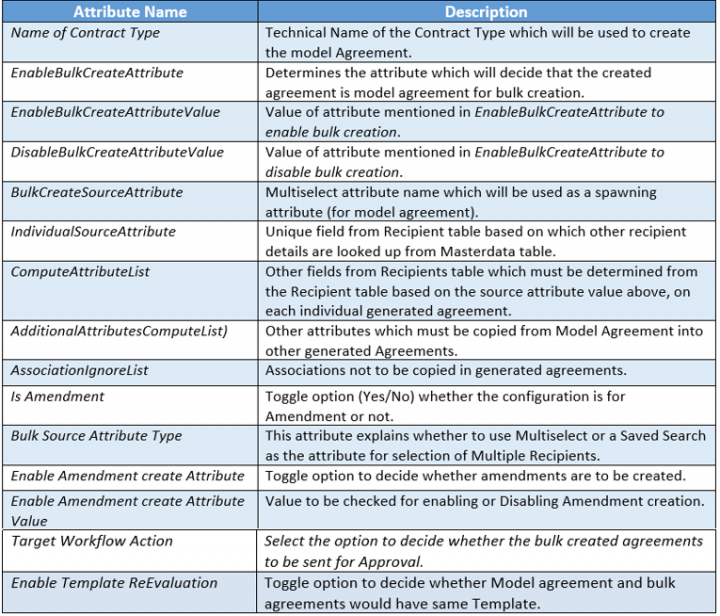
The seeded masterdata attributes in ICM:
Let us consider an example where we create an agreement using the contract type Automation All DataTypes Attributes which is already configured for the bulk creation.
1. Click the Agreement Management tile on the Home page. The Agreement Management menu opens.
2. Click the Create Agreement menu. The Create Agreement menu opens.
3. Select the Contract Type Name. For example, Agreement CT with All DataTypes Attributes.
4. Select Type Of Paper as Own.

8. Enter All Data in the Test Case Id field.


Users have the ability to define sub-roles for the Approver role. This flexibility enables all the capabilities of the Approver for the users at the sub-role level.
For example, you can now set different types of approvers for an agreement based on functions such as legal approver, finance approver, and so on. This can be achieved through a technical configuration.
User roles can be provided while Provisioning users.
1. Click User Administration >Users > Provision Users. The Provision User page opens.

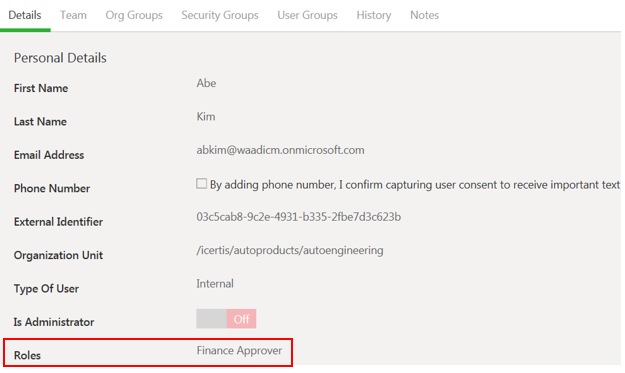
The user created above can create a User Group.
To create a User Group:
1. Click User Administration > User Groups > Create. The Create User Group page opens.
2. On the Details tab, enter the Name and Description for the user group.
3. Click Next. The Users tab opens.
4. Click Add User icon. The Add User window opens.
5. Select the sub-roles for the User Group from the Roles drop-down. For example, Finance Approver, Investment Approver.
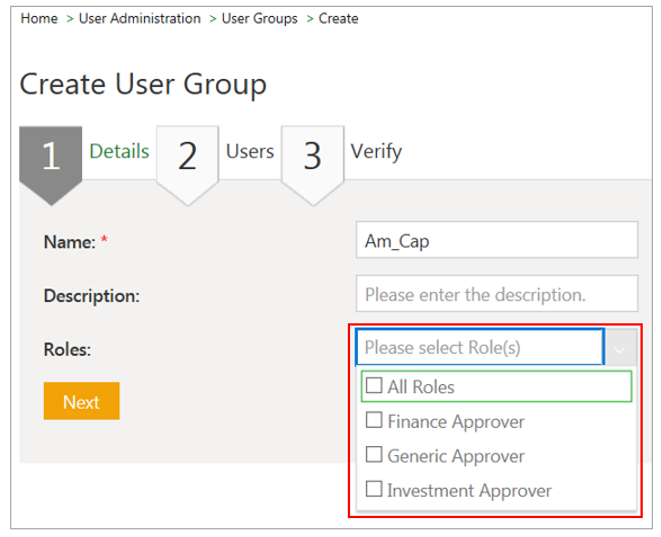
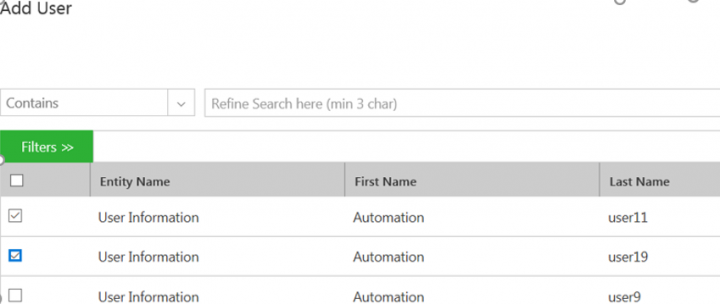
You can add a user for a sub-role by creating a Rule. The user Roles drop-down is only available for the Approval Rule and Notification Rule types.
1. Click Configuration > Rule > Create Rule. The Create Rule page opens.
2. Select the Contract Type from the drop-down.
3. Enter the Rule Name and Rule Description.
4. Select the Rule Type. For example, Approval Rule. The Team Role field is displayed.
5. Select a Team Role for the user. For example, Approver.
6. Click Next. The Build tab opens.
7. Click the Add Rule button.
8. In the Action section, select Require Approval From Any.
9. Select the User Role from the drop-down. For example, Finance Approver.
10. Click the Search User icon to select a user for the sub-role. The Search User window opens.
11. Click Add after selecting the user.
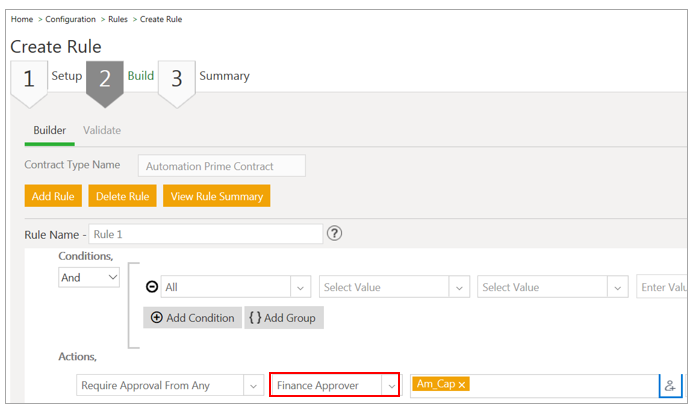
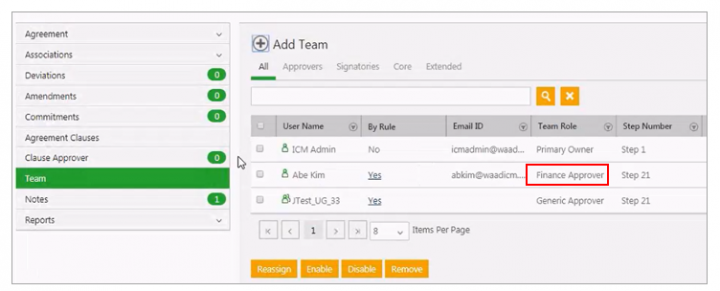
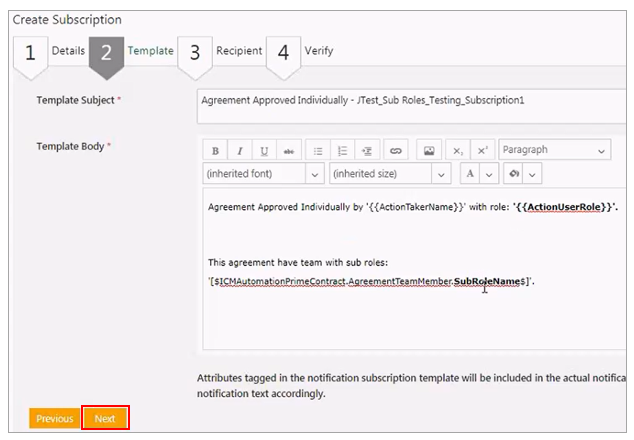
6. Click the Add Recipients icon to add the recipient. The Add Recipients window is displayed.
8. Click Next. The Verify tab opens.
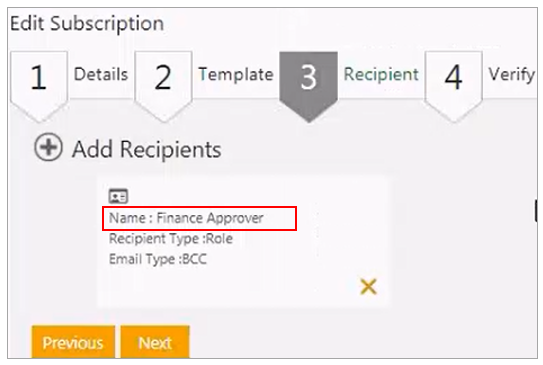
This functionality has the following limitations:
The access control for Agreements and Amendments has been extended to control additional agreement level tasks and actions based on the user role.
Users can control:
Consider an example where the agreement Automation AssoTwocolumn has the user added in the team as Approver. The agreement action Broadcast has the user role Approver mapped for the agreement in Draft state. If you remove the role approver from this role-action mapping, he or she will no longer has the access to the Broadcast action on agreement page for Draft state.
Click on the Team tab in the left panel configuration on the agreement details page to view the users added in the team. For example, user William Fagan is added as Approver for the agreement Automation AssoTwocolumn.
The role-action mapping for the agreement Broadcast action for Draft state has user role Approver mapped.
Now remove the user role Approver from the Broadcast action and Draft state.
To edit the role action mapping:
The user with role Approver will then not be able to view the action Broadcast for the agreement in Draft state.
The access to the associated documents of the agreement can be controlled by role action mapping.
Only authorized users can:
To control access on the associations creation action from agreement details page through role-action mapping:
The Create Associations action for Automation Annexure Assembly on the left panel configuration will be disabled for all users other than Primary Owner. For example, the Create Association action is disabled for the user William Fagan with the user role as an Approver.
Only authorized users can edit, dissociate or copy associations from agreement-association grid page. These actions are controlled using role-action mappings defined for respective parent-child or peer-to-peer associated document contract type.
To control access on the association actions through role-action mapping:
When the user other than above roles tries to access the agreement, the Edit, Dissociate and Copy actions will not be visible to him from the agreement-association grid page.
For example, the Edit, Dissociate and Copy action are not visible to the user William Fagan with the user role as an Approver.
You can add Static and Dynamic filters after configuring the filters on Masterdata records. For more information about Static and Dynamic filters configuration, see Applying filters on Masterdata records.
1. Click the Agreement Management tile on the Home page. The Agreement Management menu opens.
2. Click the Create Agreement menu. The Create Agreement menu opens.
3. Select the Contract Type Name. For example, MSA.
4. Select Type Of Paper as Own.



1. Click the Agreement Management tile on the Home page. The Agreement Management menu opens.
2. Click the Create Agreement menu. The Create Agreement menu opens.
3. Select the Contract Type Name. For example, MSA.
4. Select Type Of Paper as Own.


ICM provides the flexibility to select and use masterdata attributes as extensions to agreements and associated documents at the time of instance creation. Users can create rules to add or remove these extended attributes to agreement and associated documents. ICM capabilities support the extension attributes in the same way as normal attributes.
Users can:
The authorized users can control the access privileges for the actions Configure Attributes and Re-evaluate Rule on the Extension Attributes page during agreement creation through Role-Action Mapping.
The users with role as Business Owner will now be able to access the action Configure Extension Attributes for the agreement entities in Approved state. For example, user Anushree added to the agreement’s team as Business Owner can access Configure Attributes action on Extension Attributes page for the agreement entities in Approved state.
Authorized users can restrict the access to extension attributes for specific users using Attributes Group Privileges.
To restrict the access:
The user with roleBusiness Owner will be restricted to access the selected attribute group in selected state. For example, user Anushree (added as Business Owner to the agreement’s team) will not be able to access Location Details attributes for the RFQ contract type in Approved state.
Users can make the attributes of masterdata available for extension by setting Is available to be used as Extension field to Yes. Masterdata contract types which have this field value set to Yes will only be available for extension on the Configure Attributes window during agreement creation.
To edit the masterdata:
The masterdata Food Master is then available on the Configure Attributes window in the Select Contract Type drop-down during agreement creation.
Examples of different attribute types available as extension attributes
Attribute types such as conditional, lookup, computations (enable expressions), tracking, multi-select choice and so on can be configured to support extension attributes.
For example, the masterdata Vehicle Master has types of attributes which can be extended. The attribute Place of delivery Vehicle is conditional attribute and it’s value depends upon the Do you want to Place Order attribute’s value.
The attribute Place of Delivery Vehicle is displayed only when the attribute Do you want to Place Order is set to Yes.
Users can make the attribute mandatory by setting the Is Required For Extension attribute field On in the contract type.
For example, the attribute Vehicle Part Number is mandatory (with red asterix mark). The mandatory attributes are available on the Extension Attributes tab during agreement creation by default and users cannot remove them. For example, the delete action is disabled for the mandatory attribute Vehicle Part Number.
1. Click the Agreement Management menu. The Agreement menu opens.
2. Click Create Agreement. The Create Agreement page opens.
3. Select the Contract Type Name. For example, Quotation.
4. Select the Type Of Paper.

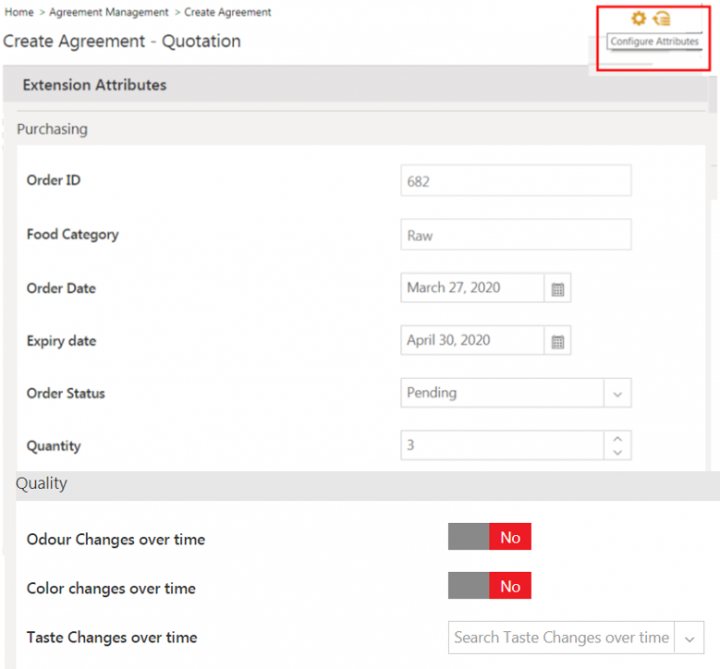


20. Click the Create Association icon in the Associations tab. The Create Association page opens.
21. Enter a Name. For example, Raw material.
22. Enter a Product ID.
23. Select the Priority from the drop-down list. For example, Medium.
24. Select the Category from the drop-down list. For example, Other.
25. Click Next. The Extension Attributes tab opens.
On clicking the Next button, the Extension Selection rule for Associated Document Contract Type (Quotation Line Item) gets triggered and all the configured attributes of Select Extension Contract Types (PurchaseMaster) and attribute groups (FoodMaster) are already selected and available in the Extension Attributes tab.
The Other category displays the three attributes Order ID, Order Date and, Order Status as per the configured Extension Selection rule.
26. Enter the Order ID.
27. Select the Order Date from the drop-down list.
28. Select the Order Status from the drop-down list.
29. Enter the details in the fields on the attribute group Quality.


37. Enter the Order ID.
38. Select the Food Category.
39. Select the Order Date.
40. Select the Expiry Date.
41. Select the Order Status from the drop-down list.
42. Enter the Quantity.
43. Click the Configure Attributes icon to add attributes during run time. The Configure Attributes window opens.
44. Enter the details in the fields on the attribute group Quality.
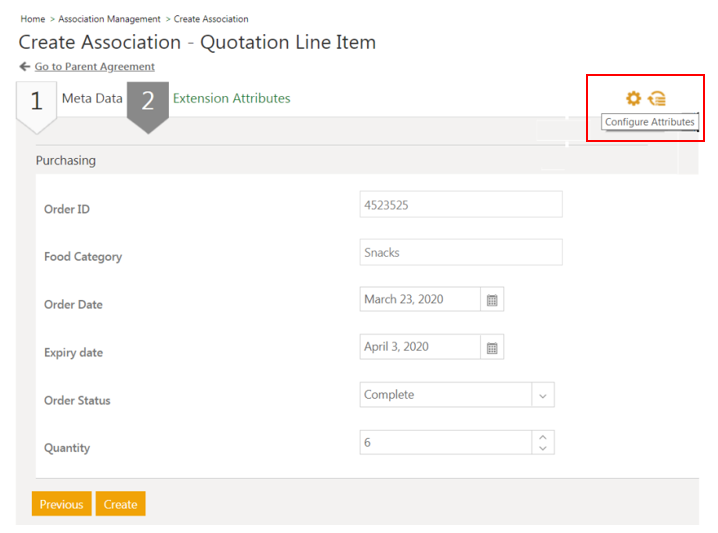
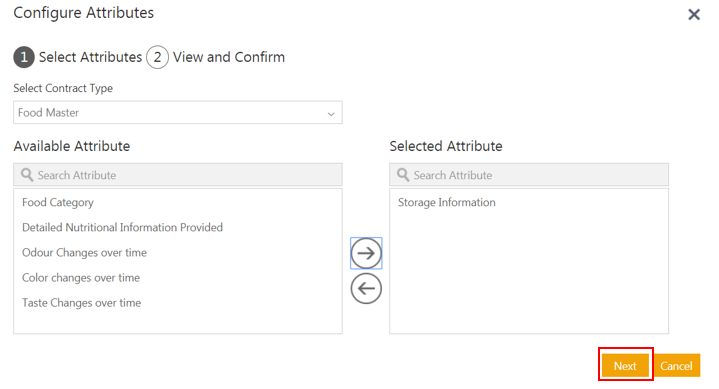


Users can save their selection of extension attributes as a template for reuse during the creation of agreement.
To save a template of the selection of extension attribute:
The selection is saved as a template and available in Select Template drop-down on the Select Attribute tab.
When user selects the saved template, the extension attributes from that template are displayed on the Extension Attributes page during agreement creation.
If the user adds a new attribute through Configure Attributes window during agreement instance creation, the existing attributes on theExtension Attributes page evaluated from the rule will be retained on the page with their values.
Users can save the selection of extension attributes as a template to create the associations for agreements or amendments instances.
To save a template for the association for the agreement:
The selected extension attributes will be available by default on the Extention Attributes page during future assocaition creations for the current agreement instance.
Changes in extension attributes are captured and can be viewed on the History tab. For example, changes in extension attribute Vehicle Type from Vehicle Master are captured.
Users can search and retrieve entities with extended attributes as search parameters and save the search criteria as a saved search. Extended attributes are available in search facets drop-downs along with regular attributes.
To search entities with extension attributes:
All the entities with extension attribute Vehicle Type will be displayed.
Refer to Using Advanced Search for details on using search filters, operators, and options.
Users can save the search criteria with extended attributes as search parameters and use as global or local Saved Search. Refer to Saved Searches for details on saving a search. Refer to Using Advanced Search for details on retrieving a Saved Search.
The Activity Panel tile helps logged on users to track, create and resume workflow actions at the agreement, association and amendment levels.
1. Click the User Administration tile on the Home page. The User Administration page opens.

1. Click the Agreement Management tile on the Home page. The Agreement Management page opens.

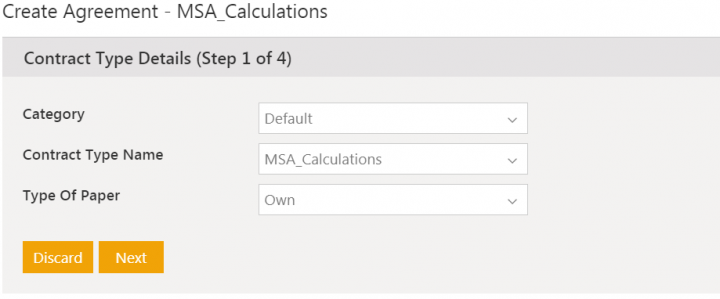
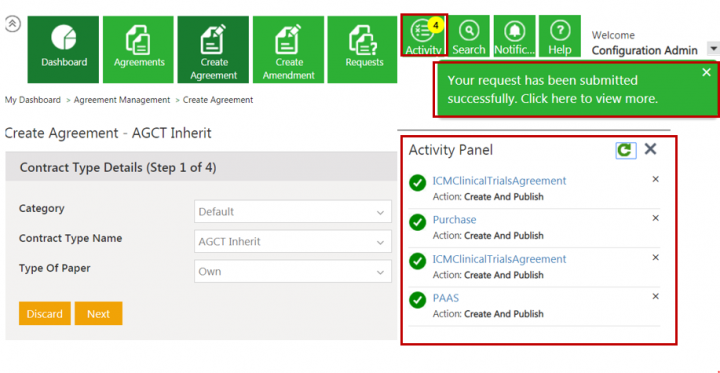
The Primary Owner can cancel or delete an agreement in any state, except executed. The Cancel button is displayed once the Agreement is published.
To cancel an Agreement:
1. Open the Agreement that you wish to cancel from the Agreements page.
2. Click Cancel. The he Add Note page opens.
3. Select a Reason Code and type a note for cancelling this agreement. Though this field is optional, it should be used to enter detailed notes for future reference. The Reason Code is mandatory; select one from the drop down list.
4. Click Add. The status of the agreement changes to Cancelled.
The cancellation action appears in the History section of the Agreement Details page. The cancelled Agreement continues to be displayed in the Agreement searches and you can revert cancelled agreements to draft state from the Agreement Details page.
You can edit an Agreement at any stage till it is executed. Editing an executed agreement involves going through the approval process with both internal and external parties again.
To edit an existing Agreement:
1. Click the View Record icon next to the Agreement you wish to edit on the Agreements page. The Agreement Details page opens.
2. Click Edit. The Create Agreement page opens.
3. Follow the steps in Creating an Agreement section to edit the Agreement.
4. Click Update to save your changes.
5. Click Upload Document to upload the new version fot he docuemnt. When a new document version is uploaded to ICM, the user is redirected to the Versions page.
Users can copy an existing agreement and create a new agreement using Copy Record functionality. The resulting agreement will be a copy of existing agreement with all the metadata and selected associated documents from existing source agreement. The source agreement’s latest approved template will be selected by default to create the copy.
Authorized users can configure Agreement Contract Type and set Allow Copy With Associations field to Yes to enable Copy record. The agreement created using this specific Contract Type will have Copy Record feature enabled by default.
To configure agreement contract type:
You can also edit the existing contract type and set the Allow Copy With Associations to Yes to enable the Copy Record functionality.
Follow these steps to copy an Agreement:
1. Click the Agreement Management > Agreement on the Home page. The agreement index page opens.
2. Click View Record icon next to the Agreement for which you would like to create copy.
3. Click Copy Record icon. The Copy Record page opens.
4. Select the Associated Documents and Commitments that you want to copy in addition to the Agreement Metadata in the resulting Agreement. You can either select the Associations and Commitments checkbox to select all available Associated Documents and Commitments or select the checkboxes for specific Associated Documents and Commitments.
Exclude auto-attached associated documents during copy
ICM allows attaching standard documents from the masterdata repository as associations to the agreement based on the defined event rule on the agreement.
When a user copies the agreement with auto-attached associations, system excludes all auto attached associations from being copied to the new agreement. The auto-attached associations won’t be displayed on the Copy Record window. The resulting agreement has the selected manual associations and its own auto-attached associations as per the configured rules.
This avoids the unnecessary upload of files into the ICM repository and duplication of association records on copied agreement as it will have its own auto-attached documents.
Users can select auto-attachment associations when an agreement is sent for signature along with the bundled association and download all associations of an agreement in the ZIP format.
You can copy the agreement by clicking Copy Record icon next to the agreement name on the agreement index page.
You can only copy published agreements. The error message will be displayed if users try to copy non-published agreement.
Click Ok to go back to the agreement index page.
To copy an agreement from agreement index page:
When Allow Copy with Association in the Agreement Contract Type is False and users try to copy the agreement from agreement index page, the confirmation message is displayed.
After clicking Ok, the agreement will be copied and new agreement is generated in Draft status.
Only users with manage privileges can copy the agreement record. The error message will be displayed if unauthorized users try to copy the agreement.
Click Ok to go back to the agreement index page.
For example, consider a scenario where a user (non-owner) is using a document as third party paper created by the user (owner) and makes some changes in the Word document and sends it to the owner. The owner then uploads the modified version of the Word document. ICM now also supports document assembly, data sync (of metadata, clauses), etc. of the agreement document.
1. Click the Agreement Management tile on the Dashboard. The Agreement Management page opens.
2. Click the Create Agreement tab. The Create Agreement page opens.
3. Enter all the details on the Create Agreement page.
4. Select Own for Type Of Paper.
5. Select Contract Type Name. For example, Clinical Trials Agreement.
6. Follow the steps to create the agreement. It is now in the Draft state.
1. Click the Agreement Management tile on the Dashboard. The Agreement Management page opens.
2. Click the Create Agreement tab. The Create Agreement page opens.
3. Enter all the details on the Create Agreement page.
4. Select a Contract Type Name. For example, MSA_SD.
5. Select the Type Of Paper field. The Non-Owner will select the Third Party type of paper.
6. Click Next. The Attributes tab opens.
7. Upload the owner’s document to non-owner ICM instance.
8. Follow the remaining steps to send the agreement to the Draft state. The document gets uploaded with a message indicating that Document Assembly is restricted for this agreement.
Now make some changes in the agreement document at Non-Owner’s ICM instance that is uploaded in the Owner’s instance. For example, change tagged effeective date December 10, 2019 to December 12, 2019 in the document.
1. Click Upload Document in the Owner’s instance. The Upload Document window opens.
2. Click Select File to upload the modified agreement document.
3. Click Upload File. The Please Confirm window opens indicating the changes in the original document.
4. Click Yes.
5. Click Preview in the agreement Details tab. You can now view the changes that were made to the agreement document at Non-Owner’s instance in the owner’s instance as well.
ICM has eliminated the need to use external tools such as Email, Skype, etc. and created a dedicated space available within the Agreement itself to collaborate between multiple stakeholders.
To collaborate, multiple stakeholders involved in the contracting/sourcing process can:
This can be achieved by setting the Enable Collaboration flag to Yes for the Agreement Contract Type, which displays a Collaboration tab on the Agreement Details page. To prevent data loss, once Collaboration is enabled for a Contract Type, it cannot be disabled.
Configuring Collaboration for Contract Types
To enable Collaboration for Contract Types:
1. Click the Configuration tile on the Dashboard. The Configuration page opens.

8. Click Next. The Attributes tab opens.
9. Enter the details in the remaining Attributes, Association, Display Preference, Team, and Verify tabs to send the Collaboration Contract Type to Approved state. Alternatively, you can edit an already existing Contract Type to enable the Collaboration tab.
1. Click the Agreement Management tile on the Dashboard. The Agreement Management page opens.

6. To select Participants for the Topic, click the Add Team Members icon or you can select all Team members. The Select Participant(s) window opens. For example, let’s collaborate with an Internal user, CLM Admin.

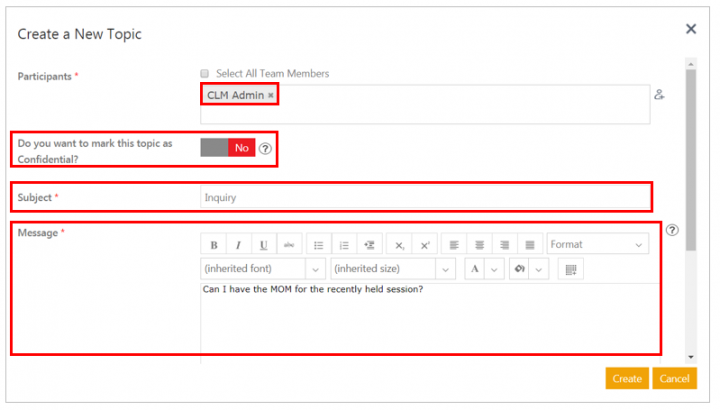
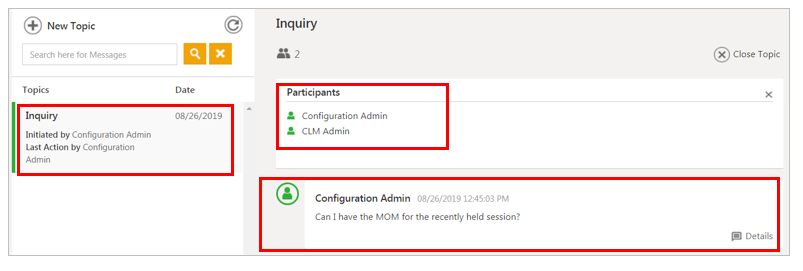
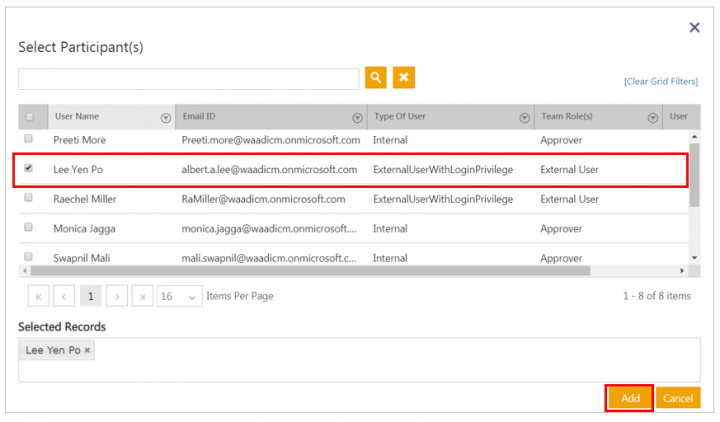


Details such as who initiated the conversation, who took the last action on a Topic, along with the Date, are displayed in the window.


1. Click the Collaboration tab of the Agreement Details page.
2. Select the Topic where you communicate with an internal user. Let’s consider topic Informal chat.
3. Click Reply to reply to the message to a single participant or click Reply All to broadcast the message to all participants. The response window opens.
4. Enter the message in the Message field.
5. Click Send.
Let’s see how the Internal user views the Internal user’s response.
Now let's see how the provisioned external user Lee Yen Po can respond to the message.
1. Click the Collaboration tab of the Agreement Details page.
2. Click Reply to respond to the selected message.
Based on confidentiality, a message posted by an external user will be visible to participants or other team members, but not external users.
3. Click Send.
For every message sent or replied in any topic triggers a notification email to its participants and has got the following conditions:
1. An email notification is sent to all participants whenever an internal or external user posts a message based on confidential condition.
2. All email notifications can be tracked from the Notifications Alerts present on the Dashboard and then Collaboration Notifications section present in the Notifications Dashboard.
A user can search messages across topics using the Search tab available in the Collaboration window.
To search messages in a topic:
1. Enter the keyword in the Search for Messages field. For example, let’s search the word - Can. All the topics where the message contains the searched criteria are rendered in the search result along with the search word is highlighted.

2. Click Yes. The Topic is now closed.
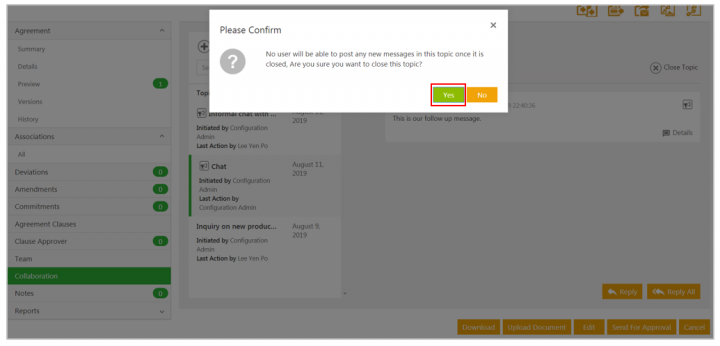
1. Click Saved Searches and select the specific one on which you need to perform the Bulk Action. This displays the Agreements matching the criteria defined in the Saved Searches, with checkboxes next to it.
2. Select the checkboxes next to the Agreements on which the action has to be taken as shown in the figure below.
3. Click the Bulk Action icon. This displays a list of actions that you can take on the selection. For example, Approve, Reject, Delete, Send for Approval, Send for External Signature and Download.
4. Clicking the required action, displays a confirmation window. Click OK.
ICM provides the ability to send the entity-wise reminder notifications by using the Subscription Reminder Notification Template.
To create a Subscription Reminder Notification Template:
1. Click the User Administration tile. The User Administration menu opens.
2. Click Notification Settings. The Notification Settings menu opens.
3. Click Subscription. The Subscriptions page opens.
4. Click Create Subscription. The Details tab of the Create Subscription page opens.
5. Enter the Template Name. For example,Reminder Notification.
6. Select the entity from the Entity Name drop-down list. For example, Agreement.
7. Select the Event Name from the drop-down list. For example, Agreement Reminder.
8. Select the Category Name from the drop-down list. For example, Reminder Notifications.
9. Click Next. The Template tab opens.
10. Enter a subject in the Template Subject field. For example, Reminder Notification for [$Agreement.Name$] expiry.
11. Tag attributes from the Attributes section as per requirement.
12. Enter a message in the Template Body field.
13. Click Next. The Recipient tab opens.
14. Click the Add Recipients icon to add recipients.
15. Select recipients from the list.
16. Click Next. The Verify tab opens.
17. Click Save.
The Reminder Notification is created for Agreement. It can be viewed on the Notification Template page.
Let us now create a Rule for the Agreement Reminder Event.
To create an Event Rule:
1. Click the Configuration tile. The Configuration menu opens.
2. Click Rule. The Rule menu opens.
3. Click Create Rule. The Create Rule page opens.
4. Select the Contract Type. For example, MSA_SD.
5. Enter a Rule Name. For example, Agreement Expiry Notification.
6. Enter a description for the Rule in the Rule Description field.
7. Select Event Rule from the Rule Type drop-down list.
8. Select Agreement Reminder from the Rule Type drop-down list.
9. Click Next. The Build tab opens.
10. Click Add Rule under the Build tab.
11. Select the Contract Type from the drop-down list for which you want to apply the condition. For example, MSA_SD.
12. Select the Attribute for which you want to apply the condition from the Select Value drop-down list. For example, Created By.
13. Select the operator from the drop-down list. For example, Equals.
14. Select the user for which you want to apply the condition from the Enter Value drop-down list. For example, CLM Admin.
15. Select the Action that you want to take from the Actions drop-down list. For example, Set Recurrence Reminder.
16. Select the template from the Reminder Template drop-down list. For example, Reminder Notification.
17. Enter the value in the Interval field. For example, 1.
18. Select the frequency from the Interval Frequency drop-down list. For example, Day(s).
19. Select the date in the Start Date drop-down list from where you want to start the reminder. For example, Reminder Start Time.
20. Select the date in the End Date drop-down list from where you want to end the reminder. For example, Reminder End Time.
21. Select Yes or No in the Stop Processing More Rules drop-down list.
22. Click Next. The Summary tab opens.
The Reminder Notification for Agreement will get triggered every day for the Contract Type MSA_SD created by the user CLM Admin.
23. Click Create.
The Agreement Expiry Notification rule gets created. This can be viewed on the Rules page.
As per the event rule, reminder notification gets triggered every day and users can keep a track of notifications by using the Notifications Dashboard.
To view notifications:
1. Click the Notifications tile. The Notifications Dashboard opens.
2. Click Agreement Reminder under the Agreement Notifications tab.
3. The Agreement Reminder Notification message is displayed on the right side.
You do not have permission to edit this page, for the following reason:
You are not allowed to execute the action you have requested.
You can view and copy the source of this page:
Return to Agreements Page.